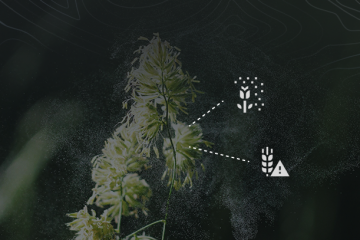Did you know that the first recorded pollen count was around the 1700s by an English microscopist. The first pollen-related allergy was identified in 1565 by Leonardo Botallo, an Italian-born Frenchman. The gap between identifying the pollen allergy and classifying the cause took about 200 years. After almost 500 years since the first case of pollen allergy, we still rely on manual methods of pollen count measurements.
But, first, let’s understand what pollen count means & why we should measure it?
Pollen is a powdery grain-like substance that’s produced by plants for the process of reproduction. The pollen count is a measurement of the number of pollen grains found in the air. It is important to measure pollen count as it causes allergies such as hayfever or allergic rhinitis.
What is the most popular method to measure pollen count today?
The most popular method to manually measure pollen count today is The RotorodTM Sampler Technique.

The RotorodTM is an air sampling device with silicone-grease-coated clear rods that rotate to collect the pollen grains in the air. Every day, two pollen collector rods are placed in the RotorodTM Sampler. The rods are greased lightly to capture and retain the pollen grains present in the air. The Rotorod sampler spins the rods through the air for 60 seconds at every 10 min interval exposing the rods to capture pollen for 6 mins/hr. The pollen captured on the rods is collected the following day for examination. The type and species of pollen grains collected are identified and sorted using microscopy.
And who counts the pollen grains daily?
What’s surprising about manual pollen tracking is that there are no government-installed measurement stations. All across the US, private companies handle the task of collecting and providing pollen data to consumers. According to the American Academy of Allergy, Asthma & Immunology(AAAAI), any individual can become a pollen tracker after taking a certification exam.
After using the Rotorod sampling method, the pollen counters will divide the collected pollen grains into three significant categories: low, standard, and high. The type of pollen grains is first identified as grasses, molds, trees, and weeds. Later, they are counted to determine whether they are primarily found or vice versa.
What values are considered high pollen count?
| Trees | 90 – 1499 |
| Grass | 20 – 199 |
| Mold | 13,000 – 49,000 |
| Weed | 50 – 499 |
What values are considered low pollen count?
| Trees | 1 – 14 |
| Grass | 1 – 4 |
| Mold | 1 – 6499 |
| Weed | 1 – 9 |
Then, what is a standard pollen count?
The standard pollen count for an area is the average pollen count found in the region. The pollen values are averaged to the type of pollen by the pollen trackers. This average value is considered the standard pollen near a region.
What are the steps you need to take if your pollen count is high?
Some of these tried & tested ways to manage seasonal allergies during high pollen levels. They are
- Reduce your exposure to the things that trigger your allergies
- Try to stay indoors on extremely windy days especially when the weather is dry.
- Cover your face with a protective layer while mowing lawns, pulling weeds, and doing chores around the garden.
- Make sure to dust the laundry after you hang dry them outside. Pollen grains can stick to certain types of materials
- Make sure to keep the air indoors clean
- Change the air filters in your air conditioning systems regularly.
- Use high-efficiency (HEPA) filters in your home & car.
- Keep your indoor air dry with an air dehumidifier
- Stay updated on the standard pollen count in your area
- Regularly check your local TV or radio station, newspaper, or internet for pollen forecasts.
- Learn when pollen seasons will arrive and how long it will last to stay prepared.
- Download the Ambee air quality, pollen & weather app to get real-time updates on the pollen in your area.
The Ambee app can give you updates on the high, low, and standard counts in your area.
Is manual pollen count measurement accurate?
When using manual methods for measuring pollen count, there are some questions that go unanswered. They are
- During what time of the day is the pollen count highest?
- How do climate and temperature affect the rise and fall of pollen count?
- At what time during the day does the pollen count appear in the air?
Advanced or detailed analysis of pollen count behavior is necessary to answer these questions. Now more than ever, it is essential to have accurate measurement techniques as climate change makes pollen seasons unpredictable. We need a measuring process that reports pollen data by the hour. Thanks to advanced analytics, earth observation satellites, and data science techniques, there is a way to measure pollen accurately.
Is there a solution to accurate pollen count measurement?
Yes, there is. Most allergies are driven by environmental factors like wind, temperature, storms, humidity, and a particular species of plants growing in specific areas. All plants have predictable behavior. Some species of plants require high humidity to burst and create allergens; others are blown away by the force of the wind. To precisely understand when this process will occur, the information on different locations of all species of tree, grass, and weed pollen is collected. With the help of machine learning (ML), this information is pulled together to predict the conditions & symptoms of allergens. This method will first identify the best factors for your location by considering the atmospheric conditions and predict pollen count.
How does Ambee provide its pollen count?
Ambee collects raw data from its thousands of on-ground sensors and multiple earth observations satellites and integrates them into a series of models. These proprietary models first clean & sort the data and then co-relate it with insights that will strengthen the accuracy of the final product. This process results in high-resolution, highly granular, and accurate real-time pollen data.
How is the pollen count data measured today by Ambee different?
There is an extensive list of uncertainties related to manual pollen count measurement. The Rotorod technique provides pollen counts for a limited area and a fixed period (daily). But a method that pretty much gets data directly from the source–the atmosphere has much more advantages.
- The pollen count API gives accurate insights into variations in seasons across the globe.
- Research-backed data science techniques and ML algorithms are much more constant and accurate when compared with manual counting of pollen grains. (There is an added human error involved too)
- Pollen count data from this technology has a high resolution down to street-by-street level and can give alerts at hourly intervals.
- Since satellite data does the collection, the pollen count levels are available for most locations worldwide.
A Dataset That Helps The World Heal
The constant evolution of pollen count measurement has been nothing but promising. We believe that this cutting-edge technology powered by scientifically validated datasets can potentially transform the lives of millions.
Using real-time pollen data, we can prevent future risks associated with pollen allergies. We can identify trends and build better action plans with historical pollen data. The possibilities are endless when it comes to the application of pollen data.




